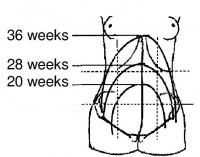Trauma In Pregnancy: Difference between revisions
Jump to navigation
Jump to search
(Created page with "==Section 7 - PEDIATRIC / OBSTETRICAL== ===7.12 Trauma in Pregnancy=== INITIAL TRAUMA CARE PRACTICE PARAMETER ( with BVM. . Check for uterine contractions, vaginal bleeding...") |
No edit summary |
||
| (2 intermediate revisions by the same user not shown) | |||
| Line 2: | Line 2: | ||
===7.12 Trauma in Pregnancy=== | ===7.12 Trauma in Pregnancy=== | ||
INITIAL TRAUMA CARE PRACTICE PARAMETER ( | [[Initial Trauma Assessment and Care|INITIAL TRAUMA CARE PRACTICE PARAMETER (2.02)]] [[Oxygen|OXYGEN]] @ 100% via NRB mask or assist with BVM. | ||
with BVM. | *Check for uterine contractions, vaginal bleeding and / or leaking amniotic fluid. Assess for fetal movements. | ||
*Raise right side of backboard approximately 30 degrees. | |||
for fetal movements. | *If hypotension / shock present, refer to [[Shock|SHOCK PRACTICE PARAMETER (5.13)]]. | ||
*If patient in labor refer to the [[Emergency Childbirth|EMERGENCY CHILDBIRTH PRACTICE PARAMETERS (7.06)]]. | |||
[[File:Fundal_Heights.jpg|200px|thumb|left| | ====EMERGENCY C-SECTION==== | ||
*Maternal health and well being should not be compromised to save a fetus of any gestational age. | |||
*Emergency C-Section should only be considered when maternal death has verified and is determined to be irreversible | |||
**Trauma that cannot support life accompanied by a rhythm that cannot support life. | |||
**Trauma with [[Asystole|ASYSTOLE (4.02)]] or No vitals with [[Asystole|ASYSTOLE (4.02)]] | |||
**'''''“Injuries and rhythm that is inconsistent with life.”''''' | |||
* Fetus viability- 24 weeks gestational age or greater. | |||
* For optimal survival C-Section should be performed within 4 minutes of maternal death | |||
*Assess fetal heart tones if possible | |||
* Prepare Equipment- OB kit, trauma pads, and infant resuscitation equipment. | |||
* Locate anatomical landmarks for incision-Xiphoid Process and Pubis | |||
* Using a scalpel, perform vertical incision midline between-Xiphoid Process and Pubis | |||
** Cut through each layer of the abdominal wall with the scalpel and/or scissors. | |||
**Lift skin and pull apart working through the layers | |||
**Using the scalpel make initial incision in the uterus. | |||
**Using scissors cut the uterine wall. | |||
**Remove neonate, | |||
**Suction the neonate’s airway. | |||
**Double clamp the cord | |||
**Keep the infant lower than the mother. | |||
**Wait for the cord to stop pulsating, | |||
**Record APGAR at 1 and 5 minutes. | |||
**Transport to the appropriate facility. | |||
[[File:Fundal_Heights.jpg|200px|thumb|left|Fundal Heights]] | |||
[[Category:Pediatric and Obstetrical|0712]] | |||
Latest revision as of 14:39, 24 April 2020
Section 7 - PEDIATRIC / OBSTETRICAL
7.12 Trauma in Pregnancy
INITIAL TRAUMA CARE PRACTICE PARAMETER (2.02) OXYGEN @ 100% via NRB mask or assist with BVM.
- Check for uterine contractions, vaginal bleeding and / or leaking amniotic fluid. Assess for fetal movements.
- Raise right side of backboard approximately 30 degrees.
- If hypotension / shock present, refer to SHOCK PRACTICE PARAMETER (5.13).
- If patient in labor refer to the EMERGENCY CHILDBIRTH PRACTICE PARAMETERS (7.06).
EMERGENCY C-SECTION
- Maternal health and well being should not be compromised to save a fetus of any gestational age.
- Emergency C-Section should only be considered when maternal death has verified and is determined to be irreversible
- Trauma that cannot support life accompanied by a rhythm that cannot support life.
- Trauma with ASYSTOLE (4.02) or No vitals with ASYSTOLE (4.02)
- “Injuries and rhythm that is inconsistent with life.”
- Fetus viability- 24 weeks gestational age or greater.
- For optimal survival C-Section should be performed within 4 minutes of maternal death
- Assess fetal heart tones if possible
- Prepare Equipment- OB kit, trauma pads, and infant resuscitation equipment.
- Locate anatomical landmarks for incision-Xiphoid Process and Pubis
- Using a scalpel, perform vertical incision midline between-Xiphoid Process and Pubis
- Cut through each layer of the abdominal wall with the scalpel and/or scissors.
- Lift skin and pull apart working through the layers
- Using the scalpel make initial incision in the uterus.
- Using scissors cut the uterine wall.
- Remove neonate,
- Suction the neonate’s airway.
- Double clamp the cord
- Keep the infant lower than the mother.
- Wait for the cord to stop pulsating,
- Record APGAR at 1 and 5 minutes.
- Transport to the appropriate facility.
